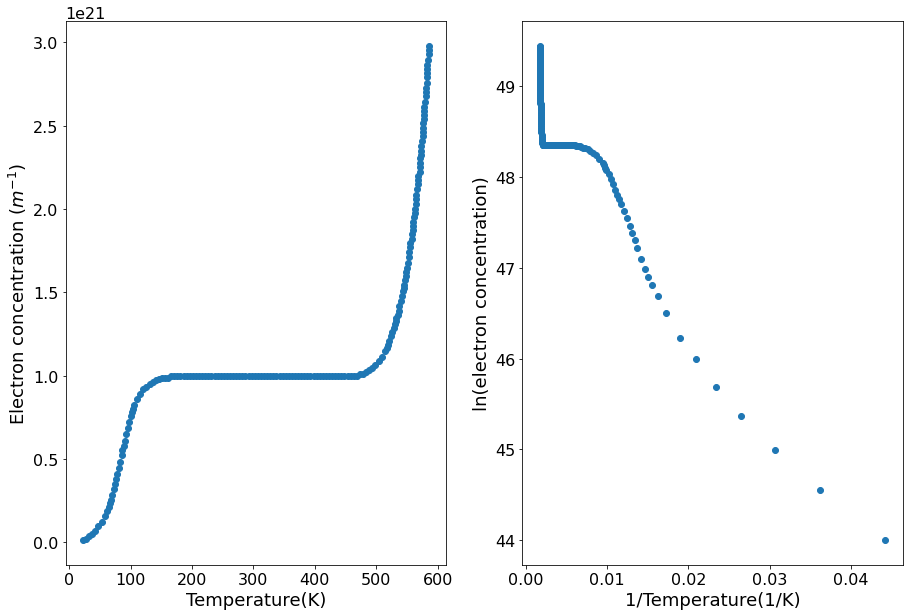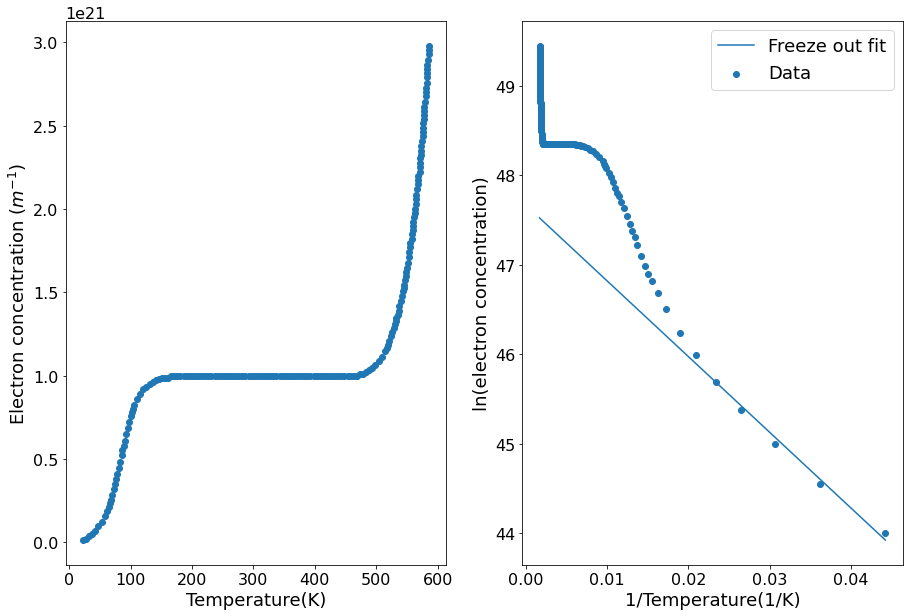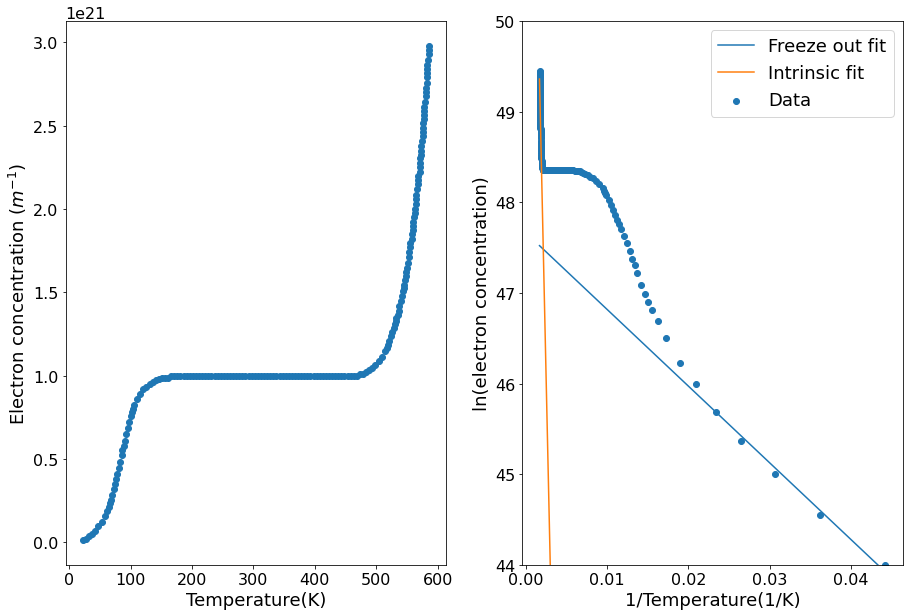Problem 3 - Answers¶
The data in the file data.txt shows temperature and electron concentration for n-type silicon doped with phosphorus atoms. Using this data find
The concentration of the phosphorus atoms
The dopant ionisation energy
The band gap energy
import numpy as np
from matplotlib import pyplot as plt
temp, e_conc = np.loadtxt("data.txt", unpack=True)
inverse_temp = 1/temp
ln_e_conc = np.log(e_conc)
params = {
'axes.labelsize': 18,
'font.size': 18,
'legend.fontsize': 18,
'xtick.labelsize': 16,
'ytick.labelsize': 16,
'figure.figsize': [15, 10]
}
plt.rcParams.update(params)
fig, [ax1, ax2] = plt.subplots(nrows=1, ncols=2)
ax1.scatter(temp, e_conc)
ax1.set(xlabel="Temperature(K)",
ylabel="Electron concentration ($m^{-1}$)")
ax2.scatter(inverse_temp, ln_e_conc)
ax2.set(xlabel="1/Temperature(1/K)",
ylabel="ln(electron concentration)")
plt.show()

The dopant concentration can be found by looking at the electron concentration in the flat portion of the graph. In this region the electron concentration is the same as the dopant concentration. In this case the dopant concentration is \(1\times10^{21}\).
The dopant ionisation energy can be found by a linear fit of the freeze-out region of the graph. In our case this is at inverse temperatures greater than 0.02 K\(^{-1}\). The gradient will be \(-E_d/2k_b\).
kb = 1.38064852e-23
# Select data in freeze out region
freeze_out_indicies = np.where(inverse_temp > 0.02)
freeze_out_temp = inverse_temp[freeze_out_indicies]
freeze_out_concentration = ln_e_conc[freeze_out_indicies]
fit_freeze_out = np.polyfit(freeze_out_temp, freeze_out_concentration, 1)
function_freeze_out = np.poly1d(fit_freeze_out)
gradient = fit_freeze_out[0]
E_d = -gradient * 2 * kb
print("The dopant ionisation energy is %.2e" % E_d)
fig, [ax1, ax2] = plt.subplots(nrows=1, ncols=2)
ax1.scatter(temp, e_conc)
ax1.set(xlabel="Temperature(K)",
ylabel="Electron concentration ($m^{-1}$)")
ax2.scatter(inverse_temp, ln_e_conc, label="Data")
ax2.plot(inverse_temp, function_freeze_out(inverse_temp), label="Freeze out fit")
ax2.set(xlabel="1/Temperature(1/K)",
ylabel="ln(electron concentration)")
ax2.legend()
plt.show()
The dopant ionisation energy is 2.34e-21

The band gap energy can be found by a linear fit of the intrinsic region of the graph. In our case this is at inverse temperatures less than 0.002 K\(^{-1}\). The gradient will be \(-E_g/2k_b\).
# Select data in intrinsic region
intrinsic_indicies = np.where(inverse_temp < 0.002)
intrinsic_temp = inverse_temp[intrinsic_indicies]
intrinsic_concentration = ln_e_conc[intrinsic_indicies]
fit_intrinsic = np.polyfit(intrinsic_temp, intrinsic_concentration, 1)
function_intrinsic = np.poly1d(fit_intrinsic)
gradient = fit_intrinsic[0]
E_d = -gradient * 2 * kb
print("The band gap energy is %.2e" % E_d)
fig, [ax1, ax2] = plt.subplots(nrows=1, ncols=2)
ax1.scatter(temp, e_conc)
ax1.set(xlabel="Temperature(K)",
ylabel="Electron concentration ($m^{-1}$)")
ax2.scatter(inverse_temp, ln_e_conc, label="Data")
ax2.plot(inverse_temp, function_freeze_out(inverse_temp), label="Freeze out fit")
ax2.plot(inverse_temp, function_intrinsic(inverse_temp), label="Intrinsic fit")
ax2.set(xlabel="1/Temperature(1/K)",
ylabel="ln(electron concentration)",
ylim=[44, 50])
ax2.legend()
plt.show()
The band gap energy is 1.12e-19

